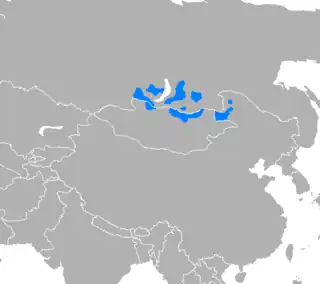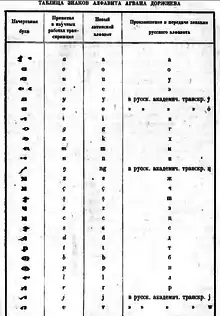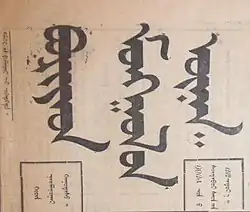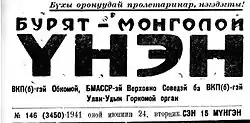Buryat language
Buryat or Buriat,[1][2][lower-alpha 1] known in foreign sources as the Bargu-Buryat dialect of Mongolian, and in pre-1956 Soviet sources as Buryat-Mongolian,[note 1][4] is a variety of the Mongolic languages spoken by the Buryats and Bargas that is classified either as a language or major dialect group of Mongolian.
| Buryat | |
|---|---|
| Buriat | |
| буряад хэлэн buryaad khelen ᠪᠤᠷᠢᠶᠠᠳ ᠮᠣᠩᠭᠣᠯ ᠬᠡᠯᠡᠨ | |
| Native to | Eastern Russia (Buryatia Republic, Ust-Orda Buryatia, Aga Buryatia), northern Mongolia, Northeast China (Hulunbuir, Inner Mongolia) |
| Ethnicity | Buryats, Barga Mongols |
Native speakers | 440,000 (2017–2020)[1] |
Mongolic
| |
| Cyrillic, Mongolian script, Vagindra script, Latin | |
| Official status | |
Official language in | Buryatia (Russia) |
| Language codes | |
| ISO 639-2 | bua Buriat |
| ISO 639-3 | bua – inclusive code BuriatIndividual codes: bxu – Inner Mongolian (China) Buriatbxm – Mongolia Buriatbxr – Russia Buriat |
| Glottolog | buri1258 |
| ELP | |
 | |
 Buryat is classified as Definitely Endangered by the UNESCO Atlas of the World's Languages in Danger | |

Geographic distribution
The majority of Buryat speakers live in Russia along the northern border of Mongolia where it is an official language in the Republic of Buryatia and was an official language in the former Ust-Orda Buryatia and Aga Buryatia autonomous okrugs.[5] In the Russian census of 2002, 353,113 people out of an ethnic population of 445,175 reported speaking Buryat (72.3%). Some other 15,694 can also speak Buryat, mostly ethnic Russians.[6] Buryats in Russia have a separate literary standard, written in a Cyrillic alphabet.[7] It is based on the Russian alphabet with three additional letters: Ү/ү, Ө/ө and Һ/һ.
There are at least 100,000 ethnic Buryats in Mongolia and Inner Mongolia, China, as well.[8]
Dialects
The delimitation of Buryat mostly concerns its relationship to its immediate neighbors, Mongolian proper and Khamnigan. While Khamnigan is sometimes regarded as a dialect of Buryat, this is not supported by isoglosses. The same holds for Tsongol and Sartul dialects, which rather group with Khalkha Mongolian to which they historically belong. Buryat dialects are:
- Khori group east of Lake Baikal comprising Khori, Aga, Tugnui, and North Selenga dialects. Khori is also spoken by most Buryats in Mongolia and a few speakers in Hulunbuir.
- Lower Uda (Nizhneudinsk) dialect, the dialect situated furthest to the west and which shows the strongest influence by Turkic
- Alar–Tunka group comprising Alar, Tunka–Oka, Zakamna, and Unga in the southwest of Lake Baikal in the case of Tunka also in Mongolia.
- Ekhirit–Bulagat group in the Ust’-Orda National District comprising Ekhirit–Bulagat, Bokhan, Ol’khon, Barguzin, and Baikal–Kudara
- Bargut group in Hulunbuir (which is historically known as Barga), comprising Old Bargut and New Bargut[9]
Based on loan vocabulary, a division might be drawn between Russia Buriat, Mongolia Buriat and Inner Mongolian Buriat.[10] However, as the influence of Russian is much stronger in the dialects traditionally spoken west of Lake Baikal, a division might rather be drawn between the Khori and Bargut group on the one hand and the other three groups on the other hand.[11]
Phonology
Buryat has the vowel phonemes /i, ɯ, e, a, u, ʊ, o, ɔ/ (plus a few diphthongs),[12] short /e/ being realized as [ɯ], and the consonant phonemes /b, g, d, tʰ, m, n, x, l, r/ (each with a corresponding palatalized phoneme) and /s, ʃ, z, ʒ, h, j/.[13][14] These vowels are restricted in their occurrence according to vowel harmony.[15] The basic syllable structure is (C)V(C) in careful articulation, but word-final CC clusters may occur in more rapid speech if short vowels of non-initial syllables get dropped.[16]
Vowels
| Front | Central | Back | ||
|---|---|---|---|---|
| Close | i | ɯ | u | |
| ʊ | ||||
| Mid | e | (ə) | o | |
| ɔ | ||||
| Open | a | |||
[ɯ] only occurs as a sound of a short e. [ə] is only an allophone of unstressed vowels.
Other lengthened vowel sounds that are written only as diphthongs are heard as [ɛː œː yː].
Consonants
| Bilabial | Alveolar | Palatal | Velar | Glottal | |||||
|---|---|---|---|---|---|---|---|---|---|
| plain | pal. | plain | pal. | plain | pal. | ||||
| Plosive | aspirated | tʰ | tʲʰ | ||||||
| voiced | b | bʲ | d | dʲ | ɡ | ɡʲ | |||
| Fricative | voiceless | s | ʃ | x | xʲ | h | |||
| voiced | z | ʒ | |||||||
| Nasal | m | mʲ | n | nʲ | (ŋ) | ||||
| Lateral | l | lʲ | |||||||
| Rhotic | r | rʲ | |||||||
| Approximant | j | ||||||||
[ŋ] only occurs as an allophone of /n/.
Stress
Lexical stress (word accent) falls on the last heavy nonfinal syllable when one exists. Otherwise, it falls on the word-final heavy syllable when one exists. If there are no heavy syllables, then the initial syllable is stressed. Heavy syllables without primary stress receive secondary stress:[17]
ˌHˈHL [ˌøːɡˈʃøːxe] "to act encouragingly" LˌHˈHL [naˌmaːˈtuːlxa] "to cause to be covered with leaves" ˌHLˌHˈHL [ˌbuːzaˌnuːˈdiːje] "steamed dumplings (accusative)" ˌHˈHLLL [ˌtaːˈruːlaɡdaxa] "to be adapted to" ˈHˌH [ˈboːˌsoː] "bet" LˈHˌH [daˈlaiˌɡaːr] "by sea" LˈHLˌH [xuˈdaːliŋɡˌdaː] "to the husband's parents" LˌHˈHˌH [daˌlaiˈɡaːˌraː] "by one's own sea" ˌHLˈHˌH [ˌxyːxenˈɡeːˌreː] "by one's own girl" LˈH [xaˈdaːr] "through the mountain" ˈLL [ˈxada] "mountain"[18]
Secondary stress may also occur on word-initial light syllables without primary stress, but further research is required. The stress pattern is the same as in Khalkha Mongolian.[17]
Writing systems
From the end of the 17th century, Classical Mongolian was used in clerical and religious practice. The language of the end of the 17th—19th centuries is conventionally referred to as the Old Buryat literary and written language.
Before the October Revolution, Western Buryats clerical work was conducted in Russian language, and not by the Buryats themselves, but originally sent by representatives of the tsarist administration, the so-called clerks, the old-Mongolian script was used only by ancestral nobility, lamas and traders Relations with Tuva, Outer and Inner Mongolia.[19]
In 1905, on the basis of the Old Mongolian script, Agvan Dorzhiev developed a script known as Vagindra, which until 1910 had at least a dozen books printed. However, vagindra was not widespread.

In 1926, an organized scientific development of the Buryat romanized writing began in the USSR. In 1929, the draft Buryat alphabet was ready. It contained the following letters: A a, B b, C c, Ç ç, D d, E e, Ә ә, Ɔ ɔ, G g, I i, J j, K k, L l, M m, N n, O o, P p, R r, S s, Ş ş, T t, U u, Y y, Z z, Ƶ ƶ, H h, F f, V v.[20] However, this project was not approved. In February 1930, a new version of the Latinized alphabet was approved. It contained letters of the standard Latin alphabet (except for h, q, x), digraphs ch, sh, zh, and also the letter ө. But in January 1931, its modified version was officially adopted, unified with other alphabets of peoples USSR.
- Buryat Latin alphabet (1931–39)
| A a | B b | C c | Ç ç | D d | E e | F f | G g |
| H h | I i | J j | K k | L l | M m | N n | O o |
| Ө ө | P p | R r | S s | Ş ş | T t | U u | V v |
| X x[21] | Y y | Z z | Ƶ ƶ | ь[21] |
In 1939, the Latinized alphabet was replaced by Cyrillic with the addition of three special letters (Ү ү, Ө ө, Һ һ).
- Modern Buryat Cyrillic alphabet since 1939
| А а | Б б | В в | Г г | Д д | Е е | Ё ё | Ж ж |
| З з | И и | Й й | К к | Л л | М м | Н н | О о |
| Ө ө | П п | Р р | С с | Т т | У у | Ү ү | Ф ф |
| Х х | Һ һ | Ц ц | Ч ч | Ш ш | Щ щ | Ъ ъ | Ы ы |
| Ь ь | Э э | Ю ю | Я я |
Buryats changed the literary base of their written language three times in order to approach the living spoken language. Finally, in 1936, Khorinsky oriental dialect, close and accessible to most native speakers, was chosen as the basis of the literary language at the linguistic conference in Ulan-Ude.
| Cyrillic (official) | Latin (modern) | Latin (historical) |
|---|---|---|
| А, а | A, a | A, a |
| Б, б | B, b | B, в |
| В, в | V, v | V, v |
| Г, г | G, g | G, g |
| Д, д | D, d | D, d |
| Е, е / Э, э | E, e | E, e |
| Ё, ё | Yo, yo | Jo, jo |
| Ж, ж | J, j | Ƶ, ƶ |
| З, з | Z, z | Z, z |
Buryat Alphabet Table
| Cyrillic (с 1939) | Latin (1930-1939) | Latin (1910) | Mongolian Script |
|---|---|---|---|
| А а | A a | A a | ᠠ |
| Б б | B b | B b | ᠪ |
| В в | V v | - | ᠸ |
| Г г | G g | G g | ᠭ |
| Д д | D d | D d | ᠳ |
| Е е | - | - | - |
| Ё ё | - | - | - |
| Ж ж | Ƶ ƶ | J j | ᠵ |
| З з | Z z | Z z | - |
| И и | I i | I i | ᠢ |
| Й й | J j | Y y | ᠶ |
| К к | K k | - | ᠺ |
| Л л | L l | L l | ᠯ |
| М м | M m | M m | ᠮ |
| Н н | N n | N n | ᠨ, ᠩ |
| О о | O o | O o | ᠣ |
| Ө ө | Ө ө | Eo eo | ᠥ |
| П п | P p | P p | ᠫ |
| Р р | R r | R r | ᠷ |
| С с | S s | C c | ᠰ |
| Т т | T t | T t | ᠲ |
| У у | U u | U u | ᠣ |
| Ү ү | Y y | Eu eu | ᠥ |
| Ф ф | F f | - | - |
| Х х | H h, K k | H h | ᠬ |
| Һ һ | X x | X x | ᠾ |
| Ц ц | C c | C c | - |
| Ч ч | Ç ç | - | ᠴ |
| Ш ш | Ş ş | S s | ᠱ |
| Щ щ | - | - | - |
| Ъ ъ | - | - | - |
| Ы ы | Ь ь | - | - |
| Ь ь | - | - | - |
| Э э | E e | E e | ᠡ |
| Ю ю | - | - | - |
| Я я | - | - | - |
Grammar
Buryat is an SOV language that makes exclusive use of postpositions. Buryat is equipped with eight grammatical cases: nominative, accusative, genitive, instrumental, ablative, comitative, dative-locative and a particular oblique form of the stem.[23]
Numerals
| English | Classical Mongolian | Khalkha | Buryat | |
|---|---|---|---|---|
| 1 | one | nige | neg | negen (нэгэн) |
| 2 | two | qoyar | khoyor | khoyor (хоёр) |
| 3 | three | hurba(n) | gurav | gurban (гурбан) |
| 4 | four | dörbe(n) | döröv | dürben (дүрбэн) |
| 5 | five | tabu | tav | taban (табан) |
| 6 | six | jirguga(n) | zurgaa | zurgaan (зургаан) |
| 7 | seven | doluga(n) | doloo | doloon (долоон) |
| 8 | eight | naima(n) | naim | naiman (найман) |
| 9 | nine | yisü | yos | yühen (юһэн) |
| 10 | ten | arba(n) | arav | arban (арбан) |
Notes
- /ˈbʊriæt/;[3] Buryat Cyrillic: буряад хэлэн, buryaad khelen, pronounced [bʊˈrʲaːt xɤ̞.ˈlɤ̞ŋ]
- In China, the Buryat language is classified as the Bargu-Buryat dialect of the Mongolian language.
References
- Buryat at Ethnologue (26th ed., 2023)

Inner Mongolian (China) Buriat at Ethnologue (26th ed., 2023)
Mongolia Buriat at Ethnologue (26th ed., 2023)
Russia Buriat at Ethnologue (26th ed., 2023)
- Hammarström, Harald; Forke, Robert; Haspelmath, Martin; Bank, Sebastian, eds. (2020). "Buriat". Glottolog 4.3.
- Laurie Bauer, 2007, The Linguistics Student’s Handbook, Edinburgh
- Тодаева Б. Х. Монгольские языки и диалекты Китая. Moscow, 1960.
- Skribnik 2003: 102, 105
- Russian Census (2002)
- Skribnik 2003: 105
- Skribnik 2003: 102
- Skribnik 2003: 104
- Gordon (ed.) 2005
- Skribnik 2003: 102, 104
- Poppe 1960: 8
- Svantesson, Tsendina and Karlsson 2008, p. 146.
- Svantesson et al. 2005: 146; the status of [ŋ] is problematic, see Skribnik 2003: 107. In Poppe 1960's description, places of vowel articulation are somewhat more fronted.
- Skribnik 2003: 107
- Poppe 1960: 13-14
- Walker 1997
- Walker 1997: 27-28
- Окладников А. П. Очерки из истории западных бурят-монголов.
- Барадин Б. (1929). Вопросы повышения бурят-монгольской языковой культуры. Баку: Изд-во ЦК НТА. p. 33.
- Letter established in 1937
- "Buryat romanization" (PDF). Institute of the Estonian Language. 2012-09-26. Archived (PDF) from the original on 2015-04-27. Retrieved 2016-01-20.
- "Overview of the Buriat Language". Learn the Buriat Language & Culture. Transparent Language. Retrieved 4 Nov 2011.
Further reading
- Poppe, Nicholas (1960): Buriat grammar. Uralic and Altaic series (No. 2). Bloomington: Indiana University.
- Skribnik, Elena (2003): Buryat. In: Juha Janhunen (ed.): The Mongolic languages. London: Routledge: 102–128.
- Svantesson, Jan-Olof, Anna Tsendina, Anastasia Karlsson, Vivan Franzén (2005): The Phonology of Mongolian. New York: Oxford University Press.
- Walker, Rachel (1997): Mongolian stress, licensing, and factorial typology. (Online on the Rutgers Optimality Archive website: roa.rutgers.edu/article/view/183.)
- Санжеев Г. Д. (1962). Грамматика бурятского языка. Фонетика и морфология [Sanzheev, G.D. Grammar of Buryat. Phonetics and morphology] (PDF, 23 Mb) (in Russian).
- (ru) Н. Н. Поппе, Бурят-монгольское языкознание, Л., Изд-во АН СССР, 1933
- Anthology of Buryat folklore, Pushkinskiĭ dom, 2000 (CD)




